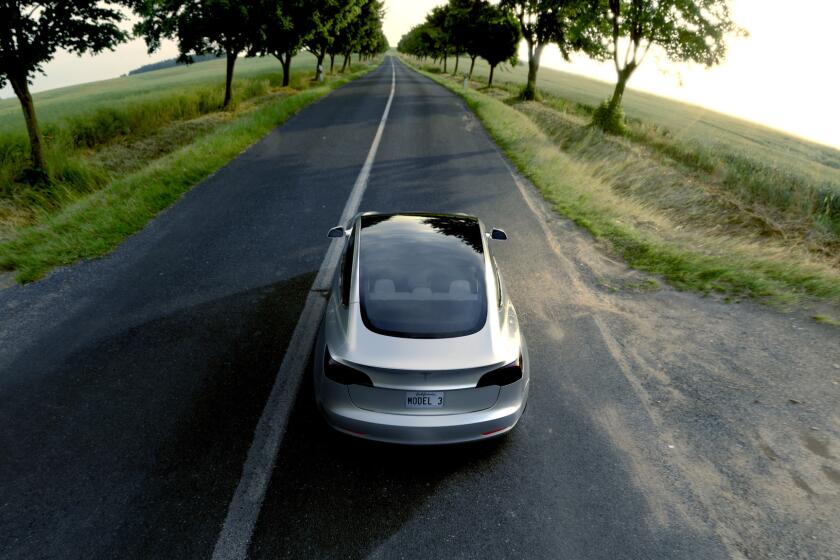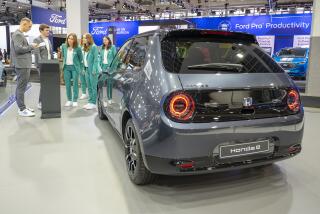Volvo shows an electric SUV and plans to drop cars running on just gas or diesel
Volvo showed its first fully electric vehicle in Los Angeles on Wednesday, part of a new branding effort to back the Swedish company’s lineup of electric and plug-in hybrid vehicles.
The XC40 Recharge compact SUV is an electric version of a gas-powered vehicle that went on the market earlier this year.
Volvo said it intends to reduce the “life cycle carbon footprint” of its vehicles by 40% per car and make its global manufacturing network carbon-neutral by 2025. That’s in line, it said, with the global climate agreement struck in Paris in 2015.
Volvo has marketed its reputation for safety over the decades. Now it wants to be known for commitment to the environment too.
“Safety is part of our DNA,” Håkan Samuelsson, chief executive of Volvo Cars, told The Times. “Let’s do exactly the same thing with sustainability.”
EV sales rose 65% in California in the first half of the year, led by Tesla. But that doesn’t mean consumers are suddenly in love with electric cars.
The company, owned by Chinese auto giant Geely, plans to introduce one fully electric vehicle each year through 2025 and a number of plug-in hybrids, which are able to run solely on electricity for a few dozen miles before power switches to internal combustion.
Volvo said it will phase out vehiclesthat run solely on gasoline or diesel fuel by 2025. In 2020, the company said, 20% of its vehicle sales will be that of plug-ins. By 2025, the company said, half of its vehicles sold will be fully electric, the other half plug-in hybrids and standard hybrids.
Carmakers in China and Europe are moving rapidly toward electrification, driven primarily by regulation. In the U.S., Ford has detailed aggressive electrification plans. General Motors and Fiat-Chrysler have been more vague. Ford is the only U.S. company that has committed to follow California emissions rules that are being contested by the Trump administration. (Joining Ford are Honda, Volkswagen and BMW.)
The XC40 is priced at about $56,000 before $7,500 federal and $2,500 California electric-car incentives are applied.
The SUV has 408 horsepower and gets about 248 miles on a charge to its 78-kWh battery. The battery, the single most expensive part of an electric vehicle, is “sizable enough to give you a fair amount of range but not so super expensive that only a minority of rich people can afford it,” said Henrik Green, Volvo’s chief technology officer.
The vehicle will employ over-the-air software updates, a first for Volvo, and the infotainment system will be based on the Google Android operating system.
It seemed like a simple plan.
While the XC40 is Volvo’s first fully electric vehicle, Volvo’s Polestar brand plans to begin selling the Polestar 2 next year. Whereas Volvo is developing multi-power-train platforms, Polestar is strictly electric drive and branded to appeal outside the usual Volvo crowd.
Volvo itself has been a bit behind the curve in electric vehicles. It will take several years to build up its pure-EV offerings. In the meantime, as it phases out liquid-fuel-only vehicles, Volvo will rely on hybrids and plug-in hybrids. Like Volkswagen and other companies banking big on plug-ins, it’s a bold move. With dozens of EVs and plug-in hybrids scheduled to hit the market over the next few years, those autos still account for less than 3% of sales both in the U.S. and in Europe.
Mark Wakefield, who heads the automotive unit at consultant AlixPartners, said plug-in hybrids are a bridge technology that already are losing ground to full EVs as batteries get cheaper and charging convenience becomes less of a problem. “Plug-in hybrids make a lot of sense right now but will make less sense in the future,” Wakefield said.
The main problem with hybrids is the cost of building two power trains — one gas-powered, one electric — in one vehicle, he said. That means either higher prices for consumers, lower profit margins for manufacturers, or both.
Wakefield said his firm calculates that internal combustion vehicles typically require 6.2 labor hours to assemble the engine, all-electric autos require 3.7 hours to assemble the motor and battery, and plug-in hybrids require 9.2 hours.
More to Read
Inside the business of entertainment
The Wide Shot brings you news, analysis and insights on everything from streaming wars to production — and what it all means for the future.
You may occasionally receive promotional content from the Los Angeles Times.












